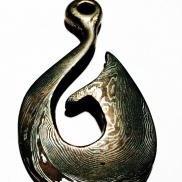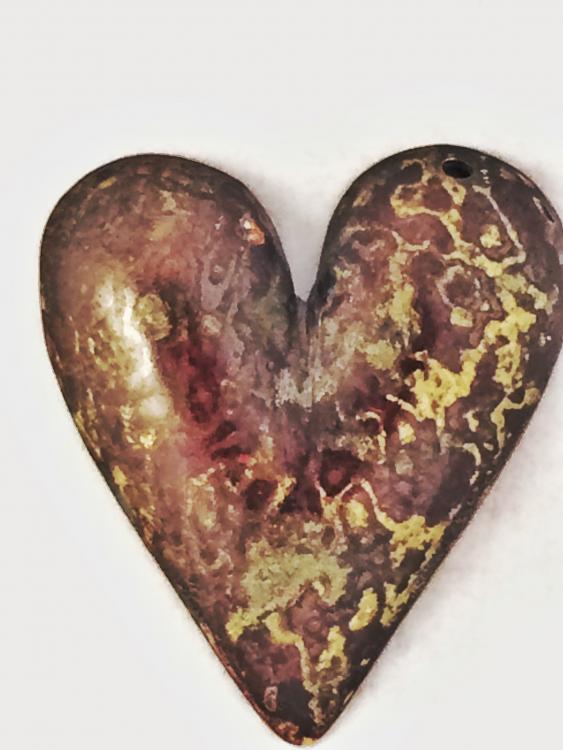-
Posts
1,081 -
Joined
-
Last visited
Content Type
Profiles
Forums
Articles
Gallery
Downloads
Events
Everything posted by teenylittlemetalguy
-
Empty is a very important point
-

If I ever say I'm going to build it instead...
teenylittlemetalguy replied to AdamG's topic in Presses
John, what size cylinder are you running with it? -
Frosty, just happened to be taking a break when your email came in. John, Nickel alloys are difficult to move without cracking. you have to make sure you are hot and don't force it else it will crack. not forgiving like twisting mild steel. Also those cracks can be really small and hard to see until you move it. Nickel is nice for the high contrast but it comes at a high labor price for you. Silver is much nicer to use. That billet was about 1.5"w 2.25"L and after welding about 5/8" thick if I remember right. I rolled it all out flat before I made anything with it. Slag has a good point about toxicity. I use 90% rubbing alcohol as it is strong enough to get the job done and less of an issue. I try not to have MEK or Acetone in my shop if I can avoid it.
-
This is a big stumbling block for people and an inherent issue to using coins since they are lumpy. IMHO Unless you take the time to flatten the coins you will almost always get what looks like cold shuts. They do not seem to go away with any amount of work. They only disappear when you overfire and melt metal so the oxides stuck in there can dissolve, which will blur your lines or completely combine all the metals into one color. You can remove the lumps by hammering the coins flat or sanding them down before welding. I would not recommend sanding Nickel alloys in your shop more than you need to as you can develop allergies. a rolling mill is nice to use if you are going to keep using coins. I recommend using flat new sheet metal. Your time into Mokume is WAY more of an investment than the extra cost of the metals. I would also recommend using something other than paper in you Jig as it burns out and reduces the pressure you put on the stack. I hear liquid paper works. I usually just make sure I have a nice layer of scale on the steel and be sure to not melt the metal. jewelers have Yellow Ochre "anti flux" that works and the welding shop will have products to stop welds as well, I forget the name right now. Here is a billet I did from copper and cartridge brass sheet. and the item I made from it. And finally. Don't get frustrated, this takes some practice to do right. Get a routine of what you know works and stick with it! don't bother with flux, it won't help. just keep the hot air off of any surface you want to weld.
-
nice looking stack!
-
Meeting in the morning in Palmer if you can make it!
-

Valentines day, what did you make?
teenylittlemetalguy replied to John B's topic in Blacksmithing, General Discussion
-

My first* coin mokume gane..(*success)
teenylittlemetalguy replied to Alwayslearning's topic in Mokume Gane
Sorry it took me so long to see this, I got no notice. I have a jewelry roller and love it. they don't open as wide as I would like though. wish I had a McDonald as well. It would be much better for items like bolsters where the jewelry ones are only good for thin stuff.- 4 replies
-
- mokume gane
- coins
-
(and 4 more)
Tagged with:
-

viking axe class
teenylittlemetalguy replied to teenylittlemetalguy's topic in Axes, Hatchets, Hawks, Choppers, etc
thank you- 33 replies
-
- broad axe
- viking axe
-
(and 1 more)
Tagged with:
-

viking axe class
teenylittlemetalguy replied to teenylittlemetalguy's topic in Axes, Hatchets, Hawks, Choppers, etc
Thank you, I couldn't be happier and I can't speak highly enough of Mr. Austin. He was a really good teacher. We usually get a guest teacher up every summer and we are trying to get him to come up so our whole group can see the process first hand.- 33 replies
-
- broad axe
- viking axe
-
(and 1 more)
Tagged with:
-

My first* coin mokume gane..(*success)
teenylittlemetalguy replied to Alwayslearning's topic in Mokume Gane
thats a good start! I bet she will love it. the good thing about pendants is they don't take a lot of stress so they hold up just fine when you have small crazing. Looking at this I would say you probably want to work harder to keep the air out from between the coins when you are heating. try hammering the coins flat before cleaning and stacking, that will be a big help I think.- 4 replies
-
- mokume gane
- coins
-
(and 4 more)
Tagged with:
-
Always, thank you. It wouldn't bother me if the thread gets derailed...8-) I have used roofing copper from a local roof supply company and it worked fine. It sometimes needs a little extra elbow grease to clean it up but is typically cheap and easy to get. I ordered some low oxygen (LOHC) copper sheet from Online Metals via the web. It was not cheap but it is really nice to work with. the only failure I have had with it was my own dumb fault. Low Oxygen High Conductivity copper is way less susceptible to cracking so it is forgiving stuff to forge and seems to weld better in my opinion. They also had some Cartridge brass sheet. it welds to the copper good. if you are using a kiln set it at 850c, or it is fine in the forge as well. I buy fine silver in an ingot and roll it out myself to whatever thickness I want. I have heard you can buy ingots of sterling, but I have never tried that. the fine silver/ copper is a nice easy combo, if you try it after doing copper/ brass be careful as it melts at a much lower temp. Good luck with it!
-

Alaska Blacksmithing groups
teenylittlemetalguy replied to Lonny's topic in Alaska Blacksmith Association
January 21st at Pats in Palmer. -
that little bear is a nice touch. I have always wanted to make a nice toybox. I still have scars from ours as a kid. (uncle had no idea how to clinch nails...)
-

I had to put a WREACH in the works.
teenylittlemetalguy replied to AK Fab Art's topic in Metal Sculpture & Carvings
hey, I like that a lot! good job! -

Not well known "stuff about horses"
teenylittlemetalguy replied to Frank Turley's topic in Farriers and Horse stuff
That is a well crafted Pun. For you today? One slow clap my friend... -

viking axe class
teenylittlemetalguy replied to teenylittlemetalguy's topic in Axes, Hatchets, Hawks, Choppers, etc
Frosty. I will be bringing it for sure!- 33 replies
-
- broad axe
- viking axe
-
(and 1 more)
Tagged with:
-

viking axe class
teenylittlemetalguy replied to teenylittlemetalguy's topic in Axes, Hatchets, Hawks, Choppers, etc
Bad um ta Ching!- 33 replies
-
- broad axe
- viking axe
-
(and 1 more)
Tagged with:
-

viking axe class
teenylittlemetalguy replied to teenylittlemetalguy's topic in Axes, Hatchets, Hawks, Choppers, etc
very true Marc1- 33 replies
-
- broad axe
- viking axe
-
(and 1 more)
Tagged with:
-

viking axe class
teenylittlemetalguy replied to teenylittlemetalguy's topic in Axes, Hatchets, Hawks, Choppers, etc
its never too late. 8-) I meant not much to learn in going from bar stock to the start of the axe, it would have taken a lot of time for not much knowlege. the class however was FANTASTIC. Jim is a great teacher, I couldn't have asked for better. yep thank you! only used the power hammer as a short cut. Most all of what you see was my hand work, and a little striking help here and there.- 33 replies
-
- broad axe
- viking axe
-
(and 1 more)
Tagged with:
-

viking axe class
teenylittlemetalguy replied to teenylittlemetalguy's topic in Axes, Hatchets, Hawks, Choppers, etc
is this the tubalcain from youtube fame? there was a power hammer used to do the initial prep from bar stock as that is all grunt and not much learning.- 33 replies
-
- broad axe
- viking axe
-
(and 1 more)
Tagged with:
-

viking axe class
teenylittlemetalguy replied to teenylittlemetalguy's topic in Axes, Hatchets, Hawks, Choppers, etc
I think you are correct in that. we get black and white thinking while there is lots of grey out there. sounds like a great resource BTW.- 33 replies
-
- broad axe
- viking axe
-
(and 1 more)
Tagged with:

